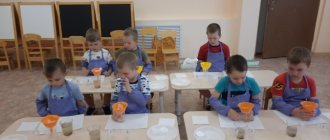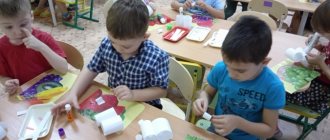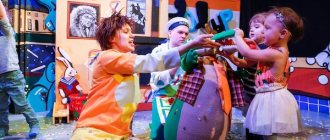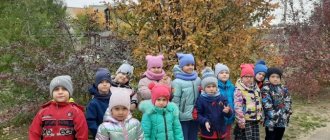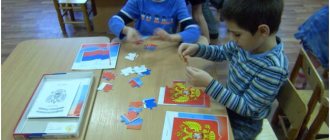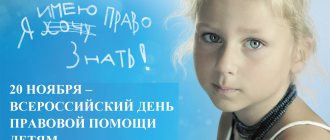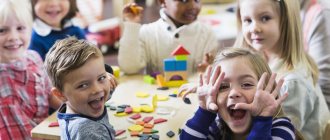MAGAZINE Preschooler.RF
In accordance with the approval and implementation of the Federal state requirements for the structure of the basic general educational program of preschool education (Order of the Ministry of Education and Science of the Russian Federation No. 655 of November 23, 2009), Federal state requirements for the conditions for the implementation of the basic general educational program of preschool education (Order of the Ministry of Education and Science of the Russian Federation No. 2151 dated July 20, 2011) the educational process in kindergarten is currently undergoing changes. The structure of the main general education program of preschool education has changed, which is considered as a model for organizing the educational process.The main feature of the organization of educational activities in preschool educational institutions at the present stage is the departure from educational activities (classes), increasing the status of play as the main activity of preschool children; inclusion in the process of effective forms of work with children: ICT, project activities, gaming, problem-based learning situations as part of the integration of educational areas. We want to share our experience in organizing educational activities at a morning group meeting, which is one of the forms of organizing the educational process in joint activities with children, where the child can show his speech activity, communication during the morning group meeting is an important routine moment. Morning gathering for preschoolers is, first of all, an opportunity to spend a few minutes together, which is important for shy children, to tell them what they think and feel. For teachers, morning assembly provides an opportunity to create an atmosphere of collective creativity, which helps to develop a sense of mutual respect and kindness among students. Consequently, one of the main requirements for a teacher’s professional skills is the ability to manage children’s interpersonal communication, resolve conflict situations, and organize creative joint activities. Svirskaya L.V. in her book she set the following tasks for a group meeting: · create a positive emotional mood for the whole day - “set the tone”; · provide conditions for interpersonal and cognitive-business communication between children and adults; · activate children’s skills regarding communication, planning and organizing their own activities; · choose the topic of a new project together with the children; · develop a plan for the implementation of a new project; · summarize the project; · instill communication culture skills; · support the desire to agree on joint activities, distribute roles and responsibilities; · teach: - formulate judgments, give reasons for statements, defend your point of view; - select the most significant, interesting events from personal experience, talk about them briefly, but consistently and logically; - listen carefully, show a constructive attitude towards the statements of others; - explain your emotional state in words and correct it; - make a choice; - plan your own activities. For more fruitful work on the development of the child, we have identified the main stages of the morning gathering: - greeting; -working with the calendar; -telling news; -discussion of the topic; -advertising activities in activity centers; -children’s choice of activity centers. Using the example of organizing activities with children at a group meeting during the project “Everyone around you knows that health is your best friend,” I will show how the tasks of developing children’s communication skills were solved. The morning gathering begins with a greeting. Before the start of which, the children and I pay attention to the stands “I have come”, “Birthday Boy’s Corner”, “Our Star”, “Meadow of Moods”. Our group has introduced a greeting duty, and it is carried out by choice. In order to diversify this stage of the group gathering, we have a card index of greetings. This is a set of cards with words and (for those who cannot read) a hint in the form of a picture. The attendant, together with the other children, accompany the spoken text with movements, at the end they touch the neighbor (petting, hugging, shaking hands, etc.) and affectionately calling his name, looking into his eyes. When learning greetings, I encourage children to clearly articulate, use facial expressions, discuss and come up with gestures, talk about why it is important to look the interlocutor in the eyes and smile. It is clear that the main task of greeting is the socialization of children, team unity, and the mood for a positive state, but at the same time the tasks of developing communication and all aspects of speech are solved. We also use poetic and song greetings; We greet with palms, shoulders, give various wishes, compliments, in general, games that create an emotional - positive mood for the whole day. Working with the calendar. Children not only mark the seasons, but also name the previous and next ones; list the signs of the current season. Our group has an additional calendar where we, together with the children, write down the signs of each month. While announcing the date (day, month, year), children repeat the names and meaning of the nearest holiday every day and mark it on the calendar with special pictures. While counting, children improve their ordinal counting skills, the ability to coordinate a noun with a numeral, and clarify the meanings of the words “more,” “less,” and “equal” (children put signs). In order to maintain interest in correct counting, we actively use a schedule for visiting children, in which the person on duty notes the number of children present on the calendar and compares them with other days of the month. Thus, in interesting, useful activities, children master the norms of their native language and learn to be leaders in collective activities. Telling the News We pay the most attention to this section of the group gathering. Children strive to share everything that fills their soul, that begs to be spoken - home events, successes and failures, childhood grievances and achievements. Children tell what the most interesting events happened in their lives, based on a diagram drawn up together with them. Sometimes we first sketch the news in the form of a pictogram, and then voice it. We often tell thematic news (rainy, autumn, fruit, etc.), which undoubtedly increases the desire for everyone to speak out. News is accepted as fact. And if time is limited, we use some tricks, for example: today only boys, or those whose names begin with vowels, share the news. And, of course, we invite the children to decide for themselves who will talk about the news today. I would like to note that children not only tell the news, but also ask questions to each other as they arise. The next stage of the morning meeting is discussion of the topic. When discussing a topic, we try to adhere to a partner’s position, ask only open questions, accept all children’s answers, teach them to defend their opinion and respect the opinions of other children. During the discussion, we use TRIZ techniques: “good and bad”, “What would happen if...”, etc. When discussing the topic “Healthy and Harmful Foods,” the children were asked the question: “Why can some foods be healthy and harmful at the same time?” The children responded as follows: When discussing any topic, in order to ensure comfortable and constructive participation of all children, we often use games or game training. Games can be anything that does not require much mobility, word games, fantasy games, joke games. For the project “Everyone around you knows that health is your best friend,” we selected the following games: ……………………………………. Advertising activities in activity centers is an important part of group gathering. Children not only choose the center they want to go to, but also decide for themselves which center can solve this or that problem. For example, during a discussion of the topic “Cleanliness is the key to health,” the children themselves concluded that we can check the cleanliness of our hands in. You can play up the situation of eating food with dirty hands in. Build a washbasin - in and “We are artists”, etc. Sometimes, when choosing a center, we use additional stimulation. For example, when choosing , children were asked, if they completed the task correctly, to attach a ray with one of the components of health to the “Sun of Health”. Children choose the desired activity, which is marked on the choice board with individual cards. The article was prepared by teachers of MKDOU d/s No. 7 in Novosibirsk Kulikova Tatyana Nikolaevna and Leonova Irina Valerievna
| Next > |
Group gathering in preschool educational institutionsmethodological development
Technology "GROUP COLLECTION" in a preschool setting.
“The purpose of education is to teach our children to do without us”
Ernst Legouwe
Currently, the educational process in kindergarten is undergoing changes. The structure of the main general education program of preschool education has changed, which is considered as a model for organizing the educational process.
The main feature of the organization of educational activities in preschool educational institutions at the present stage is the departure from educational activities (classes), increasing the status of play as the main activity of preschool children; inclusion in the process of effective forms of work with children: ICT, project activities, gaming, problem-based learning situations as part of the integration of educational areas.
The principle of developmental education, in the conditions of the Federal State Educational Standard, assumes that educational content is presented to the child taking into account his current and potential capabilities for mastering this content and performing certain actions, taking into account his interests, which contributes to development, i.e. realization of both obvious and hidden opportunities.
In my work, I like to use the pedagogical technology “morning meeting” or “group meeting”
“MORNING GATHERING” is one of the forms of organizing the educational process of joint activities with children, where the child can show his activity.
Group meeting tasks:
exchange of information about past or upcoming events, children's interests
formation of motivation for upcoming activities
providing information about materials in activity centers for the current day and planning activities in centers
making a choice of activities based on one’s own interests and needs
exchange of information about past and upcoming events, identifying children's interests
establishing belonging and community between children and adults of the group.
Group collection includes several structural elements.
— Call signs for group gathering. It is necessary to select a signal that will announce the start of the group gathering.
On one day, the game gathering begins with the ringing of a bell, on another - with the arrival of a toy hero, a hero from a fairy tale, a cartoon, big interesting news, or coverage of a problematic situation.
- Next is a short greeting “eye to eye”, conveying mood, kindness, attention. This can be the touch of palms, shoulders, elbows, noses. All this gives a positive attitude and allows children to talk and hear each other.
- Then - exchange of news. This is a very responsible and very significant part of the collection, because communication skills are developed here. Children are given the opportunity to express their thoughts and fantasies; the child can be happy for his friends or upset with them. Everyone always wants to speak out, so there are rules that are introduced together with the children, “the one with the magic wand in his hands speaks.”
-Games on the theme of the project. This component of the group gathering is aimed at expanding the information field of the thematic project, since it is possible here to communicate new knowledge, generalize existing knowledge, and meet an interesting person. I use various presentations of any part of the project by children from older groups, by a child together with a parent, or by the child himself presenting a message (for example, on the topic “Family,” a child shows and tells the family tree of his family).
— The next part of the group gathering is choosing an activity. For this purpose, the group has a “Selection Board”.
“Choice board” is one of the options for organizing independent activities for children. It is a set of pictograms indicating a particular zone. Together with the teacher, children choose pictograms to designate corners in the group where it would be interesting for preschoolers to be and engage in some activity. There are pockets under each pictogram. Then the teacher, together with the children (and at their request), makes a special badge for each child. Having chosen an activity, children place badges in the appropriate pockets. This board is most suitable for children in the preparatory group.
Before starting to work with the “Choice Board”, children sit in a circle. In a circle sit people who understand you, small and large, wishing you well and joy. The circle is a guarantee of your security. The tone of the morning meeting determines the atmosphere of the first half of the day for the entire group, and for adults, the morning meeting is a kind of indicator of understanding of children, their condition and mood.
- After the conversation, the teacher determines the time during which the children will engage in independent activities (for example, 30 minutes), and agrees with the preschoolers that they will finish the game immediately after the signal sounds (the ringing of a bell, a song or music).
- At the end of the work, the children gather in a circle again to analyze the results of their activities, and the teacher asks: “What have you done and what do you think about it?”; “You had a work plan. Did you get what you had in mind?”; “Are you satisfied with the result of your work?”
To answer, each child has a set of icons with which he answers:
Thumbs up - I tried my best, I’m happy, everything worked out!
Thumbs down - I tried, but it didn't work.
OR:
Image of the sun - I tried my best, and it worked!
An image of the sun partially covered by a cloud - I tried, but it didn’t work out.
In a group gathering, a number of opportunities are revealed for the child: the opportunity for communication, the opportunity to demonstrate independence, self-organization, the opportunity for freedom and responsibility, the opportunity for cooperation. Planning of educational work is carried out by educators together with children in the form of the development and implementation of thematic projects.
The role of the child in the Group gathering:
It is important to remember that a group gathering is not an activity, so the participation of a particular child in it is not his responsibility, but provides the opportunity for pleasant, emotionally and cognitively rich communication with peers and adults; allows you to dream together with others and make dreams come true, learn to manage yourself, your time, your teaching, gives you the opportunity to lead others (by agreement), influence current events and shape future ones.
The child has the right to independently make a decision: to continue the work or play started before the group gathering or to take part in the group gathering; join in it immediately or when he himself is ready to do so, of course, if such behavior does not violate the general atmosphere or logic of discussion of any issue that has developed at that moment. A child is not prohibited from being included in a group gathering late. He is only given to understand that if he wants to be with others, wants to play, sing, rejoice, influence events together, he should rationally plan his actions, learn to manage his time and behavior.
The role of the teacher in the Group gathering:
The role of the educator is to:
ensure comfortable and constructive participation of all children in general conversation, play, and planning;
establish and maintain a cultural framework (help children master culturally and situationally appropriate styles of behavior and communication, a culture of dialogue and monologue);
demonstrate your own pedagogical and personal attitude to the statements and ideas of children, without imposing it;
stimulate and support children’s initiatives regarding the choice of topics, content, materials, forms and methods of action;
offer children their ideas on content, types of activities, interest children and thereby solve educational problems using the material that is relevant to them;
help children choose and plan work;
provide support to all children, including those with special educational needs.
During a group meeting, key competencies are formed in the most natural way:
communicative - in games, in communication, in the exchange of news;
social – in choosing a place for action, in choosing a partner for joint activities (peer, teacher, other adult);
informational - in accessing various sources of information when discussing news, topics and content of projects, methods of action;
activity - in choosing and planning things for yourself and your friends for the current day or for the future.
health-saving – in independent regulation of activity: rest, free choice of posture, duration and speed of performing a specific task.
Group Learning is based on the belief that children develop best when they are truly engaged in learning. The carefully designed environment encourages children to explore, take initiative and be creative.
Teachers can take a creative approach to the design of the centers: together with the children, come up with a name and emblem for each center, and draw up rules of behavior in them.
These are, for example, “Lumberjack Design Bureau”, “Possession of a Soap Bubble”, “Kingdom of Brush”, “Island of Reflection”, “Skillful Hands”, “Activities”, “Get to Know”, “Experimental Bed”, etc. Developmental environment changes from topic to topic, gradually filling with products of children's activities and joint creativity of adults with children.
Thus, when acquiring new knowledge, preschoolers are given the role not of passive recipients of information, but of independent and proactive subjects of activity. They show their own research activity and desire to learn new things.
Our experience has shown that at first children evaluate themselves only positively, but gradually their self-esteem becomes more adequate. When working with the “Selection Board”, you need to consider a number of points. If, for example, a preschooler stopped playing before the scheduled time, then there may be reasons for this: insufficient amount of material, the child initially made the wrong choice, he does not know how to plan his activities. The task of the teacher who observes children is to find out what exactly the child is missing and add it to the game, teach him to properly plan his activities.
Organization of morning and evening gatheringsmaterial on the topic
Organization of morning and evening gatherings
When organizing the stay of children in a preschool group, I use a variety of methods and forms, including all children in joint activities. One of the forms of organizing the educational process in joint activities with children, where the child can demonstrate his speech activity, is communication during the morning meeting as an important routine moment. Morning gathering for children is, first of all, an opportunity to spend a few minutes together, which is important for shy children, to tell what you think and feel. For me, morning assembly gives me the opportunity to create an atmosphere of collective creativity, which helps develop a sense of mutual respect and kindness in my students.
We start the morning gathering with a greeting. I use a wide variety of its forms. This can be the touch of palms, shoulders, elbows, noses. Or you can say hello in a circle. i.e., in a chain calling each other by name, wishing good morning, health, etc. All this gives an emotional - positive mood for the whole day, allows children to talk and hear each other.
Next comes the exchange of news. Children strive to share home events, successes and failures, childhood grievances and achievements, and tell what the most interesting events have happened in their lives. Children ask questions and comment on what they hear. Thus, they learn the rules of conducting verbal dialogue, their vocabulary is enriched and activated. Children develop emotional responsiveness, goodwill, and confidence that they are loved and accepted for who they are. If time is limited, I use some tricks, for example, today only boys, or those whose names begin with vowels, share the news. And, of course, I invite the children to decide for themselves who will talk about the news today.
The next stage of group gathering is choosing an activity. Together with the children, I present the activity centers operating on this day, in which children independently plan their activities for the day, reflecting their desires on the “Choice Board”. To designate the centers, the children made symbols - circles that depict the initial letters of the names of the centers. Then they came up with cards - symbols depicting different types of activities, which children use when choosing work in the centers.
Sometimes, during classes at activity centers, behavioral problems arise, and then at the morning meeting I involve the children in developing certain rules that provide a way to implement them. The participation of children in the development of rules allows them to further exercise self-control over their behavior, and also forces them to demand that other children follow the rules.
At the evening meeting, the children gather together again to analyze the results of their activities, and I ask: “What did you do and what do you think about it?”; “You had a work plan. Did you get what you had in mind?”; “Are you satisfied with the result of your work?” Children analyze the results of work in the centers, the difficulties and problems they encountered during the day, and share discoveries and highlights.
The introduction of morning and evening gatherings helped the children increase their self-esteem and become significant in the team. They also formed moral ideas and concepts for analyzing norms and rules of behavior. The use of the “Choice Board” organized the independent activities of children, taking into account their interests, children learned to plan their activities and make the right choice, not to conflict, not to quarrel.
